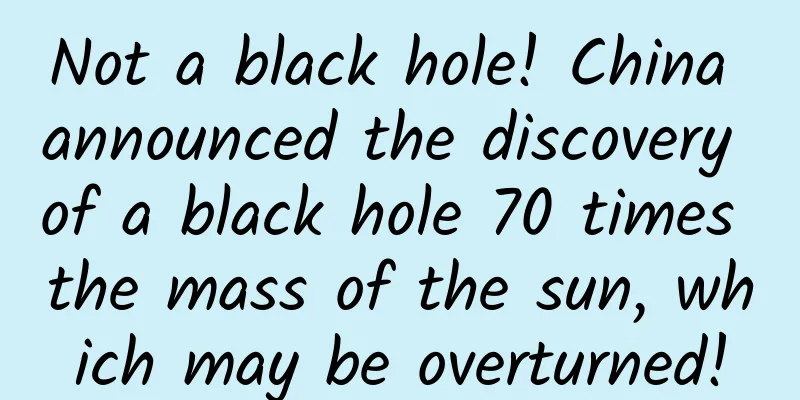Not a black hole! China announced the discovery of a black hole 70 times the mass of the sun, which may be overturned!

|
Do you remember the blockbuster discovery of a 70-times-solar-mass black hole announced by Chinese astronomers in late November 2019? Stellar black holes are formed when massive stars end their lives in a dramatic collapse. According to stellar evolution theory, the mass of a stellar black hole is usually about ten times that of the sun. Previously, on November 28, 2019, our team of Chinese astronomers announced in the journal Nature that they had discovered a black hole with a mass of 70 times that of the sun, which, if confirmed, would challenge the current view of stellar evolution. This discovery immediately triggered theoretical studies as well as additional observational studies by other astrophysicists. A team of astronomers from the University of Erlangen-Nuremberg and the University of Potsdam has carefully observed the object. They found that it may not necessarily be a black hole at all, but could be a massive neutron star or even an "ordinary" star. The results of their research have now been published as a key paper in the renowned journal "Astronomy & Astrophysics". This putative black hole was detected indirectly from the motion of a bright companion star, which orbits an invisible compact object for about 80 days. From new observations, a Belgian team has shown that the initial measurements were misinterpreted and that, in fact, the mass of the black hole is very uncertain. The most important question, namely how the observed binary system came to be, remains unanswered. A key aspect is the mass of the visible companion, LSV+2225. The more massive this star is, the more massive the black hole must be in order to induce the observed motions of the bright star, which is assumed to be a normal star with a mass of eight times that of the Sun. A team of astronomers from Friedrich-Alexander-Universität Nürnberg (FAU) and the University of Potsdam (FAU) have carefully examined archival spectra of LS V+2225 taken with the Keck telescope. Astronomers are also particularly interested in studying the abundance of chemical elements on the surface of the star. Interestingly, the abundances of helium, carbon, nitrogen and oxygen were detected that deviate from the standard composition of young massive stars. The observed surface shows the ashes produced by the nuclear fusion of hydrogen, a process that only occurs deep in the core of young stars and is not expected to be detected on their surface. "At first glance, the spectrum does look like the spectrum of a young massive star," says Andreas Irrgang, lead scientist of the study and member of the Dr. Karl Remeis-Observatory at FAU's Institute of Astronomy in Bamberg. However, several properties seemed rather suspicious, which prompted a fresh look at the archival data. The researchers believe that LSV+2 2 2 5 must have interacted with its compact companion in the past. During this mass transfer, the outer layers of the star were removed, and now a stripped helium core is visible, rich in ashes from hydrogen burning. However, a helium-stripped star is much lighter than a normal star. Combining the results with Gaia space telescope measurements determined the most likely stellar mass to be only 1.1 times the mass of the Sun (with an uncertainty of ± 0.5). So the minimum mass of the compact companion is only 2-3 times the mass of the Sun, which suggests that it may not necessarily be a black hole at all, but could be a massive neutron star or even a "normal" star. The star LS V+22 25 has gained fame as a possible massive black hole companion. However, a closer look at the star itself shows that it is a very interesting object in its own right, because although helium-stripped stars have been predicted to have intermediate masses, only a few have been discovered so far, so they are also key objects for understanding binary star interactions. Bokeyuan|www.bokeyuan.net Bo Ke Yuan | Research/From: University of Erlangen-Nuremberg Reference journal: Astronomy and Astrophysics DOI: 10.1051/0004-6361/201937343 BoKeYuan|Science, technology, research, popular science |
<<: The Origin and Experiment of the Infinite Monkey Law
>>: Why are 1 to 0 read as “一两三四五六拐怕勾洞”?
Recommend
What are the medicinal values of Rehmannia glutinosa?
Shengdihuang is what we call raw land in our dail...
Many people feel more sleepy the more coffee they drink. That means there is something wrong with this part of the body!
As a "life-saving" drink for workers, c...
Although the "sea monsters" of the pre-scientific era were exaggerated, they were very useful for maritime safety! They also created a "distortion science"?
© Library of Congress Leviathan Press: Those who ...
Sanxingdui archaeological site has a new discovery! The jade and stoneware production workshop has been found!
On the 23rd, the reporter learned from the Sichua...
The seeds of cranberries grown in the "Easternmost Part of China" are actually "chosen by God"!
Not long ago, in order to thank the Northeastern ...
Practical tips: One trick to keep mosquitoes quiet! | Expo Daily
Practical tip: One trick to keep mosquitoes quiet...
The efficacy and function of falling below
Most people are already familiar with the fact th...
Don’t laugh yet, there really is such a thing as a “sand dollar” in the world…
If you were on the beach and picked up the "...
Revealed! The college entrance examination papers were printed in prison? What did they go through to get to you?
Experts in this article: Yang Chao, PhD in Chemis...
The efficacy of snake grass water
Houttuynia cordata is a natural woody plant with ...
What is the medicinal value of Citrus aurantium
There are many medicinal values of Zhishi. For ...
The efficacy and function of the gold brush handle
In daily life, people are not only very familiar ...
Oh my god! I just found out that I can control objects remotely.
Imagine if you could make distant objects respond...





![The efficacy and function of the small brown bag [picture]](/upload/images/67ca22b488554.webp)



